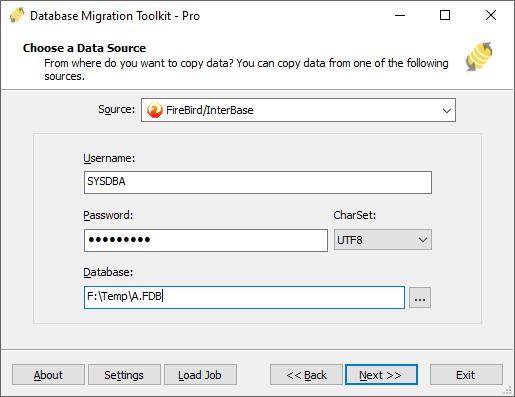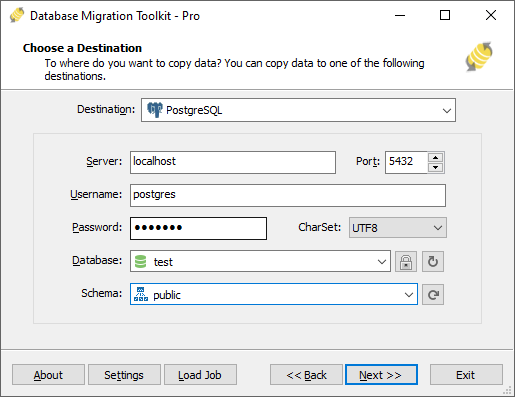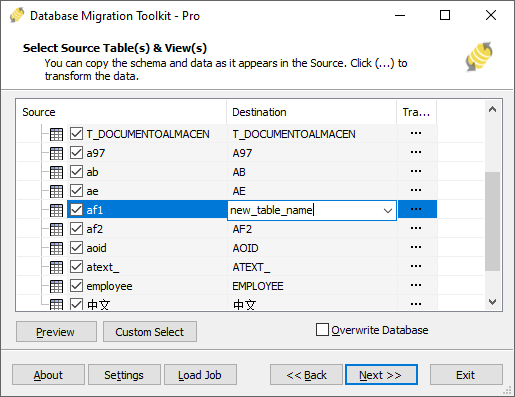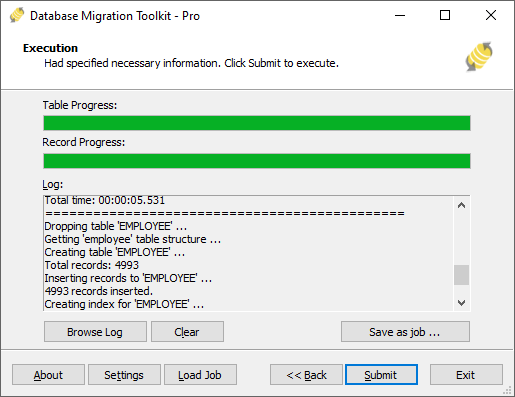Migrating data from Firebird to PostgreSQL
This guide walks you through migrating data from Firebird to PostgreSQL in a few simple steps using ESF Database Migration Toolkit. Simplify complex migration tasks and save valuable time with our streamlined approach.
Firebird vs. PostgreSQL:
- FireBird is an open-source relational database management system (RDBMS) that offers robust features, high performance, and scalability. It provides cross-platform support, running on Windows, Linux, macOS, and various Unix platforms. With its SQL compliance, ACID transactions, and multi-generational architecture, Firebird is well-suited for both small-scale applications and enterprise-level deployments. Additionally, its lightweight footprint and minimal administration requirements make it a popular choice for embedded database solutions.
- PostgreSQL is a powerful, open-source relational database management system known for its reliability, robust feature set, and extensibility. It offers support for a wide range of data types, indexing techniques, and advanced features such as full-text search, JSON support, and geospatial data processing. With a strong emphasis on standards compliance and ACID compliance, PostgreSQL is widely used across various industries for handling complex data management tasks, from small-scale projects to large-scale enterprise applications. Its active community, frequent updates, and ecosystem of extensions contribute to its popularity and ongoing development.
Prerequisite:
Software Required:
DMToolkit_x64.zip
(63.5 MiB)64-bit Windows application for ESF Database Migration Toolkit 12.2.09 (2025-07-17).
(md5: af00d640b9e71618ed20932c52f4688d)DMToolkit_win32.zip
(58.8 MiB)32-bit Windows application for ESF Database Migration Toolkit 12.2.09 (2025-07-17).
(md5: 1b7566ee53ff21b6dc8444741b9da73a)System Supported:
- Windows 7 or higher.
- Firebird 1.5 or higher.
- PostgreSQL 7.x or higher.
Step by Step Wizard:
-
Configure Firebird/InterBase Connection
- In the Choose a Data Source dialog:
- Select Firebird/InterBase from available options
- Provide authentication credentials:
- Username: SYSDBA (default)
- Password: masterkey (default)
- Select the database character set from dropdown
- Specify database location:
- Click the [...] button (Browse)
- Select your Firebird (.fdb) or InterBase (.gdb) file
- For network connections:
- Enter server address in format:
[server_name][/port][/path_to_file] - Examples:
localhost/3050:/var/db/test.fdbdbserver.example.com:/data/prod.gdb
- Enter server address in format:

Fig. 1: Configuring Firebird/InterBase data source - In the Choose a Data Source dialog:
-
Configure PostgreSQL Destination
- In the "Choose a Destination" dialog:
- Select "PostgreSQL"
- Enter server connection details:
- Server name:
localhost(default) - Port:
5432(default)
- Server name:
- Provide authentication credentials:
- Username:
postgres(default) - Associated password
- Username:
- Configure character encoding:
- Select database character set (default:
UTF8) - Required for non-ASCII characters (e.g., German, French, Japanese)
- Select database character set (default:
- Database selection/creation:
- Select existing database or enter new database name
- Click the Refresh button to list available databases
- New databases are automatically created during migration
- Schema configuration:
- Enter or select target schema name (default:
public) - Click the Refresh Schema button to list available schemas
- Enter or select target schema name (default:

Fig. 2: PostgreSQL destination configuration - In the "Choose a Destination" dialog:
-
In "Select Source Table(s) & View(s)" Dialog
-
Select migration objects: Choose tables or views to include in the migration.

Fig. 3: Select tables and views -
Modify table structure: Click the ellipsis (...) button to access table options and schema adjustments.

Fig. 4: Do transform -
Configure field mapping: In the Field Mapping options:
- Customize destination fields (name, data type, default value, comments)
- Select data transfer method:
- Overwrite Table (replace existing data)
- Empty Data (truncate before insert)
- Append Data (add to existing data)
- Skip Table (exclude from transfer)
- Apply data filters before transfer
-
Select migration objects: Choose tables or views to include in the migration.
-
Execution Dialog
-
Start migration: Click "Submit" to initiate automated data transfer from Firebird to PostgreSQL.

Fig. 5: Execute migration - Monitor progress: Click "Browse Log" for real-time migration tracking, including issue resolution details.
-
Save configuration: Click "Save as job" to store settings for:
- Quick reloads of migration jobs
- Command-line execution (use:
dmtc.exe --helpfor parameter options)
-
Start migration: Click "Submit" to initiate automated data transfer from Firebird to PostgreSQL.
-
Finished!
After migration completes, the toolkit generates a comprehensive report for verifying migration accuracy. You can monitor progress as the automated process runs efficiently. For any questions or feedback, contact us – our team is ready to assist.